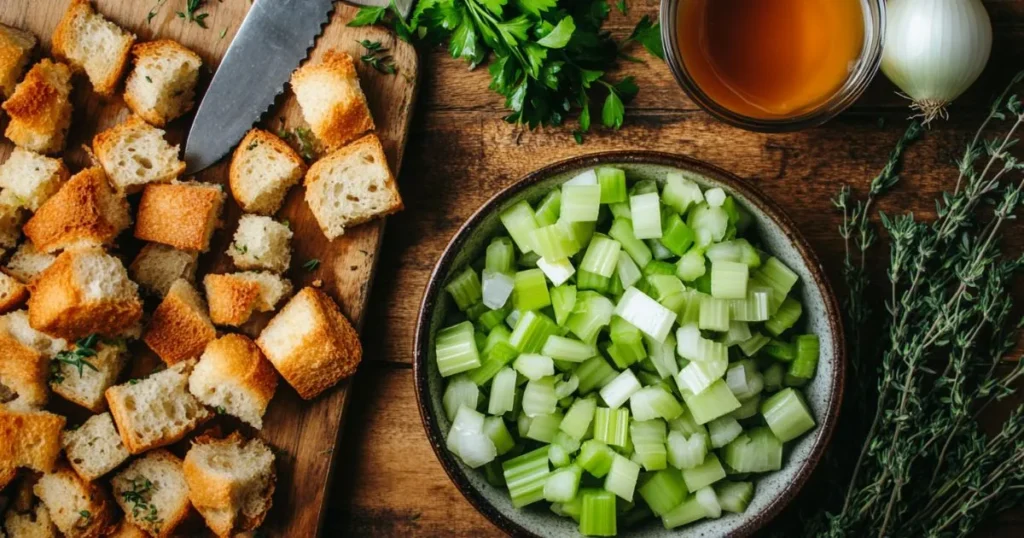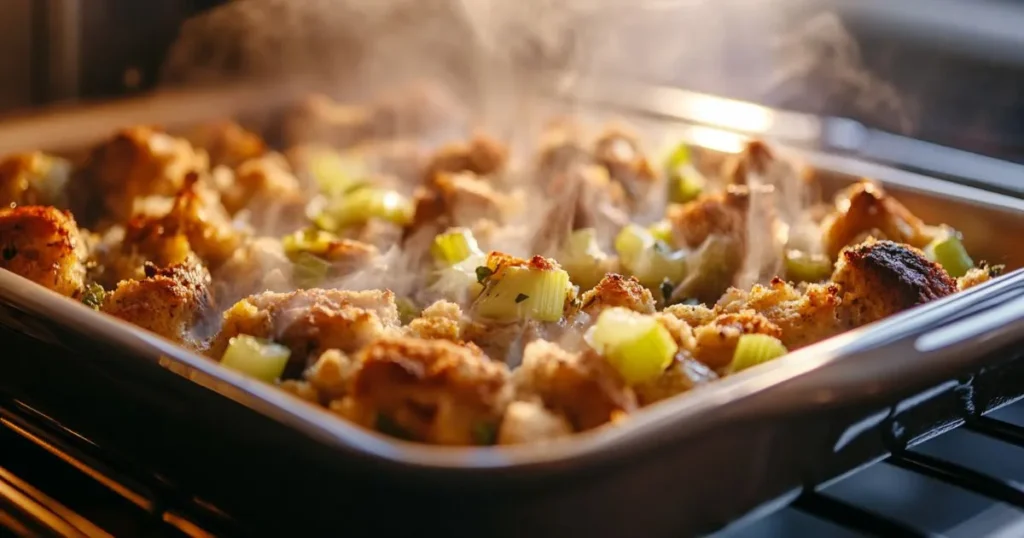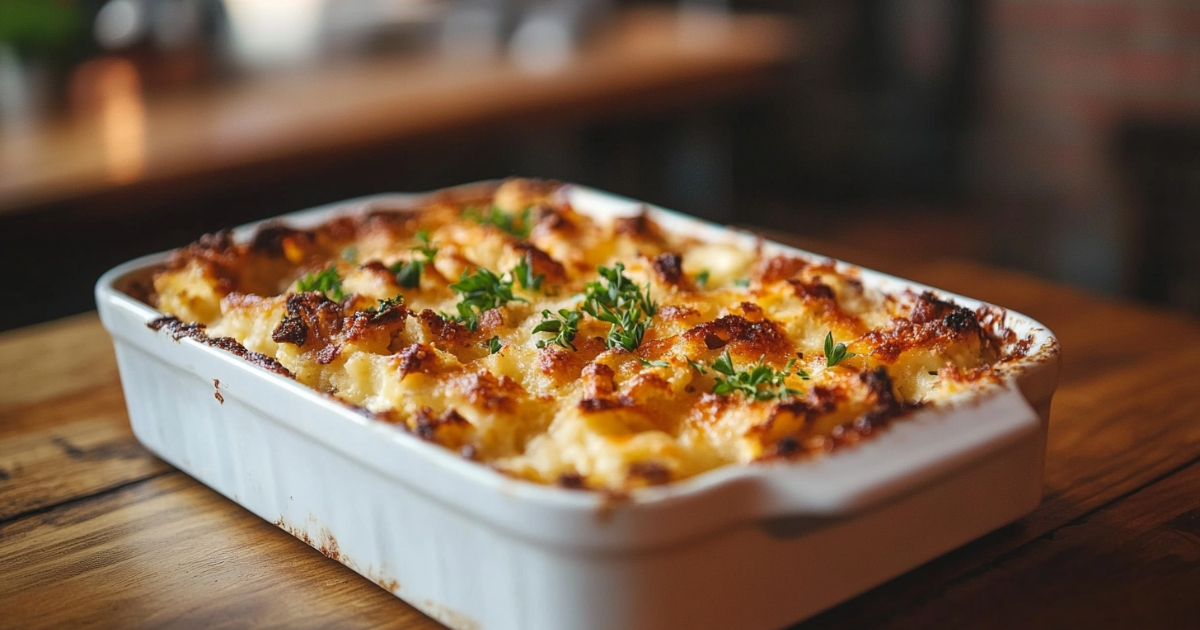Introduction
Let’s dive into the introduction, which explains the importance of addressing the main question: “Do You Fully Cook Stuffing Before Putting It in the Turkey?”
Why the Question Matters for Turkey Lovers
When it comes to preparing a Thanksgiving or holiday turkey, the stuffing is just as much a star of the meal as the bird itself. But when deciding whether to fully cook stuffing before putting it in the turkey, many cooks encounter confusion. This question is critical for anyone aiming to achieve a flavorful, moist stuffing without compromising safety. Cooking the stuffing thoroughly ensures it not only complements the turkey but also minimizes the risk of foodborne illnesses caused by undercooked ingredients.
Common Misconceptions About Stuffing Safety
A common misconception among home cooks is that stuffing cooks adequately inside the turkey during roasting. While the turkey’s exterior may reach the desired golden-brown crispiness, the internal cavity where stuffing rests can take much longer to reach a safe temperature. This creates a risk for bacteria, such as salmonella, to thrive if the stuffing remains undercooked. Fully cooking stuffing beforehand eliminates this uncertainty, ensuring it’s safe to consume while still absorbing the turkey’s rich juices during roasting.
A Quick Overview of Safe Practices
To answer the question, yes, you should fully cook stuffing before placing it inside the turkey. Start by preparing your stuffing as usual, ensuring it reaches an internal temperature of 165°F before use. Use a meat thermometer to check the final temperature after roasting the stuffed turkey. Alternatively, you can cook stuffing entirely on the side for added convenience and safety. These practices not only safeguard health but also allow you to focus on creating a delicious and memorable meal.
Table of Contents
Recipe History
This section explores the origins, evolution, and cultural significance of stuffing, shedding light on how the tradition of preparing turkey with stuffing came to be.
Origins of Stuffing in Poultry Cooking
The practice of stuffing poultry dates back thousands of years, with origins traced to ancient Rome and Egypt. Historical records show that early cooks would fill birds with a mixture of grains, nuts, herbs, and other seasonings to enhance flavor and create a heartier meal. Over time, stuffing became a symbol of abundance and celebration, appearing in feasts across various cultures. This early tradition laid the foundation for what we now consider essential to holiday meals, especially Thanksgiving in the United States.
How Cooking Techniques Have Evolved
As culinary techniques advanced, so did methods for preparing stuffing. In earlier times, stuffing was typically cooked inside the bird, as ovens and cooking equipment were less precise. However, modern food safety standards and innovations, such as meat thermometers, have made it easier to ensure stuffing is fully cooked. Additionally, many recipes now call for cooking stuffing separately to maintain both safety and a crispier texture. This shift highlights the growing awareness of safe food preparation practices while preserving the tradition of serving flavorful stuffing with turkey.
Cultural Perspectives on Turkey Stuffing
Stuffing recipes vary widely across cultures, reflecting the diverse ingredients and flavors that define regional cuisines. In the United States, stuffing often includes bread cubes, celery, onions, and poultry seasoning, while in other countries, rice, nuts, or even seafood might serve as the base. Regardless of the specific ingredients, the ritual of stuffing a turkey remains a cherished tradition, symbolizing family, comfort, and the joy of sharing meals during the holidays.
Health Benefits of This Recipe
Let’s explore how fully cooking stuffing before putting it in the turkey can contribute to a safe, nutritious, and satisfying meal.
Why Safe Preparation Matters for Health
Fully cooking stuffing before placing it in the turkey is essential to reduce the risk of foodborne illnesses. Raw poultry carries bacteria like salmonella and campylobacter, which can transfer to the stuffing if it’s cooked inside the bird. Ensuring the stuffing reaches an internal temperature of 165°F eliminates these harmful pathogens, making the dish safe for everyone at the table. This preparation method also preserves the nutritional quality of the ingredients used, such as fresh vegetables and herbs.
Nutritional Value of Cooked Stuffing
When prepared with wholesome ingredients, stuffing can provide a variety of nutrients. Bread-based stuffing offers carbohydrates for energy, while vegetables like celery and onions supply fiber and vitamins. Herbs such as sage and parsley not only enhance flavor but also contain antioxidants. By cooking the stuffing thoroughly, these nutrients are retained, giving you a dish that is both delicious and nourishing.
Ingredients and Preparation
This section provides a detailed guide on the key ingredients, steps, and techniques to prepare stuffing safely and deliciously for your turkey.
Preparing Stuffing for Cooking Inside the Turkey
If you plan to cook stuffing inside the turkey, proper preparation is crucial. Begin by combining all your ingredients—bread cubes, vegetables, herbs, and broth—in a large mixing bowl. Ensure the stuffing has a moist but not overly wet consistency, as this allows it to heat evenly inside the bird. To minimize food safety risks, always cook the stuffing mixture beforehand to an internal temperature of 165°F before placing it into the turkey cavity. This step significantly reduces the risk of bacterial contamination.

Key Ingredients to Achieve the Perfect Texture
The texture of your stuffing depends on a careful balance of ingredients. Bread cubes serve as the base, with options like sourdough or cornbread adding unique flavors. Vegetables such as onions, celery, and carrots provide crunch, while herbs like sage, thyme, and parsley deliver depth. Adding eggs can bind the mixture, creating a cohesive texture, while broth ensures the stuffing stays moist during cooking. For an extra burst of flavor, consider incorporating dried fruits or nuts.
Steps to Safely Cook Stuffing Before Use
To fully cook stuffing, transfer the prepared mixture to a baking dish. Cover it with foil and bake at 350°F for about 30 minutes. Remove the foil during the last 10 minutes to allow the top to brown slightly. Always check the stuffing’s internal temperature with a meat thermometer, ensuring it reaches 165°F. Once cooked, you can either serve the stuffing on the side or carefully spoon it into the turkey cavity for additional roasting, ensuring the turkey and stuffing maintain their safe temperatures.
Testing Doneness: Using a Meat Thermometer
A meat thermometer is an essential tool for ensuring the stuffing is fully cooked, whether inside or outside the turkey. Insert the thermometer into the center of the stuffing, avoiding contact with the edges of the pan or the turkey cavity. The USDA recommends a minimum temperature of 165°F for safe consumption. If the turkey reaches its ideal temperature before the stuffing, remove it from the oven and continue baking the stuffing separately to ensure it’s properly cooked.
Serving Suggestions
Get inspired with creative and practical ways to serve stuffing, ensuring it complements your turkey and delights your guests.
Pairing Turkey with Perfectly Cooked Stuffing
When serving turkey and stuffing together, presentation is key. Arrange slices of turkey breast on a platter with a generous helping of stuffing on the side. Garnish the dish with sprigs of fresh rosemary, sage, or parsley for a polished look. Drizzle turkey gravy over the stuffing to tie the flavors together. To highlight the stuffing’s texture and flavors, keep it warm and moist, making it the perfect companion to your turkey’s crispy skin and juicy meat.
Alternative Dishes for Leftover Stuffing
Stuffing isn’t just for turkey! Transform leftovers into unique dishes that extend the joy of your holiday meal. Use stuffing as a base for a savory breakfast casserole by adding scrambled eggs and cheese. Create stuffing-stuffed mushrooms as a crowd-pleasing appetizer, or mix it with ground turkey to form flavorful meatballs. These creative options ensure no delicious bite goes to waste.
Garnishing and Presentation Tips
A beautifully presented dish enhances the dining experience. Serve stuffing in a decorative baking dish or cast-iron skillet for a rustic touch. Add a sprinkle of fresh herbs like parsley or thyme on top for color and freshness. If you’ve included nuts or dried fruit in the recipe, use a few as a garnish for an elegant, cohesive look. These small details can make your stuffing the centerpiece of the meal.
Family-Friendly Ideas for Serving Stuffing
For family gatherings, consider serving stuffing in individual portions. Use ramekins to bake single servings or create stuffing muffins for easy plating. These options are especially popular with kids and ensure everyone gets their fair share. Pair these with kid-friendly sides like cranberry sauce or mashed potatoes to complete the meal. This approach adds a touch of fun while maintaining the delicious, comforting flavors of the dish.
Cooking Techniques
Mastering the right cooking techniques ensures your stuffing is both delicious and safe, whether cooked inside or outside the turkey.
Step-by-Step Guide to Cooking Stuffing Separately
Cooking stuffing separately is one of the safest and most effective methods to achieve perfect results. Start by preheating your oven to 350°F and preparing the stuffing mixture according to your recipe. Transfer the mixture to a greased baking dish, spreading it evenly to allow for consistent cooking. Cover the dish with foil and bake for 30 minutes. For a golden, slightly crispy top, remove the foil during the last 10 minutes of baking. Check the internal temperature with a meat thermometer to ensure it reaches 165°F before serving.

Safely Cooking Stuffing Inside the Turkey
If you prefer to stuff your turkey, there are important precautions to follow. Begin by fully cooking the stuffing mixture before placing it in the turkey cavity. Spoon the stuffing loosely into the cavity to ensure even heat distribution during roasting. Use a meat thermometer to monitor the stuffing’s internal temperature, which must reach 165°F before serving. Keep in mind that the turkey may take longer to cook with stuffing inside, so adjust your roasting time accordingly.
Tools and Equipment for Accurate Cooking
Using the right tools can make all the difference when preparing stuffing. A reliable meat thermometer is a must for checking the stuffing’s internal temperature, whether it’s cooked separately or in the turkey. Use a sturdy baking dish for oven preparation, ensuring even heat distribution. For mixing ingredients, choose a large bowl to accommodate the stuffing mixture comfortably. Silicone spatulas and wooden spoons are great for stirring ingredients without overmixing or breaking them down.
Tips to Avoid Dry or Overcooked Stuffing
Achieving the ideal stuffing texture requires careful attention to moisture and cooking time. Start by adding broth gradually to the stuffing mixture to avoid making it too wet or dry. If the stuffing seems dry while baking, drizzle extra broth over the top and cover it with foil to trap moisture. Conversely, avoid overbaking, as this can lead to a crumbly, dry texture. By monitoring the cooking process closely, you can ensure your stuffing remains moist, flavorful, and satisfying.
FAQ
In this section, we answer common questions to help clarify the safe and effective preparation of stuffing.
Do you need to cook stuffing before putting it in the turkey?
Yes, it’s highly recommended to fully cook stuffing before placing it in the turkey. Cooking the stuffing beforehand ensures it reaches a safe temperature and eliminates harmful bacteria. Uncooked stuffing inside the turkey may not heat evenly, putting your guests at risk for foodborne illnesses. Pre-cooking also allows you to better control the texture and flavor of the stuffing, ensuring it complements your roasted turkey perfectly.
What temperature should stuffing reach for safety?
The USDA advises that stuffing must reach an internal temperature of 165°F to be safe for consumption. Whether cooked inside the turkey or in a separate baking dish, always use a meat thermometer to check the temperature. If the stuffing is in the turkey cavity, make sure both the turkey and the stuffing reach their respective safe temperatures before serving.
Can you cook stuffing and turkey together safely?
Yes, you can cook stuffing and turkey together safely, but there are precautions to follow. First, ensure the stuffing is fully cooked before placing it in the turkey. During roasting, use a meat thermometer to check that the stuffing inside the turkey reaches an internal temperature of 165°F. Keep in mind that a stuffed turkey may take longer to cook, so plan your timing accordingly. If either the turkey or the stuffing doesn’t reach the correct temperature, remove the stuffing and finish cooking it separately.
What are the risks of undercooked stuffing?
Undercooked stuffing can pose serious health risks due to the potential presence of bacteria like salmonella from raw poultry juices. If the stuffing doesn’t reach a safe internal temperature of 165°F, these harmful bacteria may survive, leading to foodborne illnesses. Symptoms of such illnesses can include nausea, vomiting, and abdominal cramps. Fully cooking the stuffing eliminates these risks and ensures it’s safe to enjoy.
Conclusion
This section wraps up the blog with a summary of the key points and helpful internal links for related recipes and techniques.
The Importance of Fully Cooking Stuffing for Safety
Fully cooking stuffing before placing it in the turkey is not just a recommendation—it’s a crucial step for ensuring food safety. By pre-cooking the stuffing and verifying that it reaches an internal temperature of 165°F, you eliminate the risks associated with bacteria from raw poultry. This method also allows you to control the stuffing’s flavor and texture, ensuring it complements your turkey perfectly. Whether you choose to cook it separately or in the bird, the safety and satisfaction of your guests should always come first.
Summary of Safe Practices for Delicious Results
To recap, always pre-cook stuffing before placing it in the turkey to ensure it’s fully cooked and safe to eat. Use a meat thermometer to check that both the stuffing and turkey reach the correct internal temperatures. If you’re in doubt, cooking stuffing separately in the oven is a foolproof option that guarantees great taste and texture. These practices not only enhance food safety but also make your holiday meal stress-free and memorable.
Internal Links for Related Recipes
Looking for more inspiration for your turkey dinner? Check out these helpful resources:
- Turkey Casserole with Stuffing for a creative way to use leftovers.
- Ingredients in Turkey Casserole to explore versatile recipe ideas.
- Why Add Eggs to Turkey Stuffing? to understand how eggs can enhance your stuffing’s texture and flavor.

